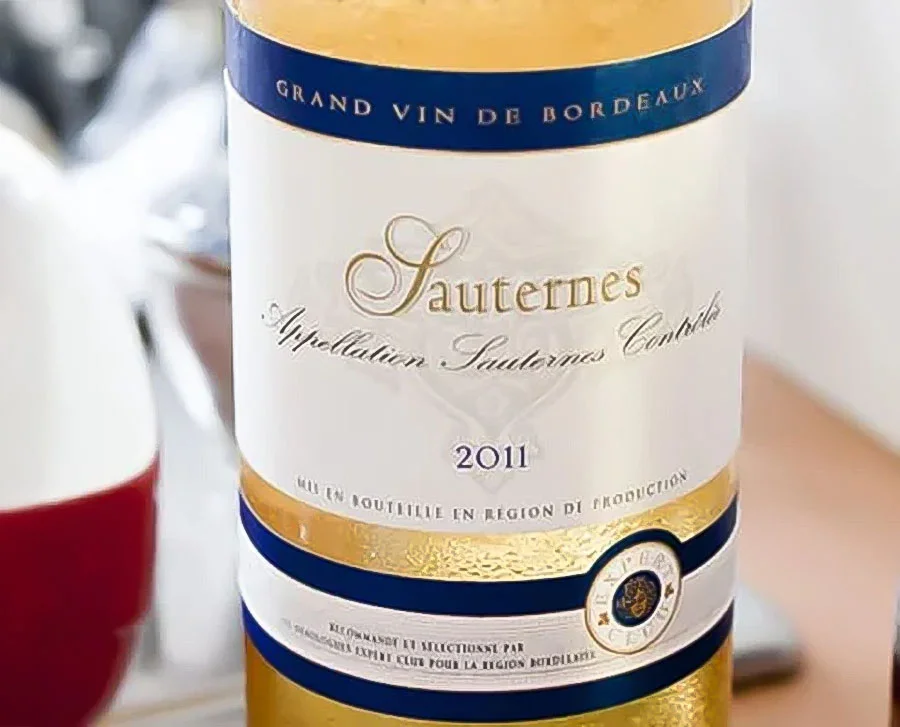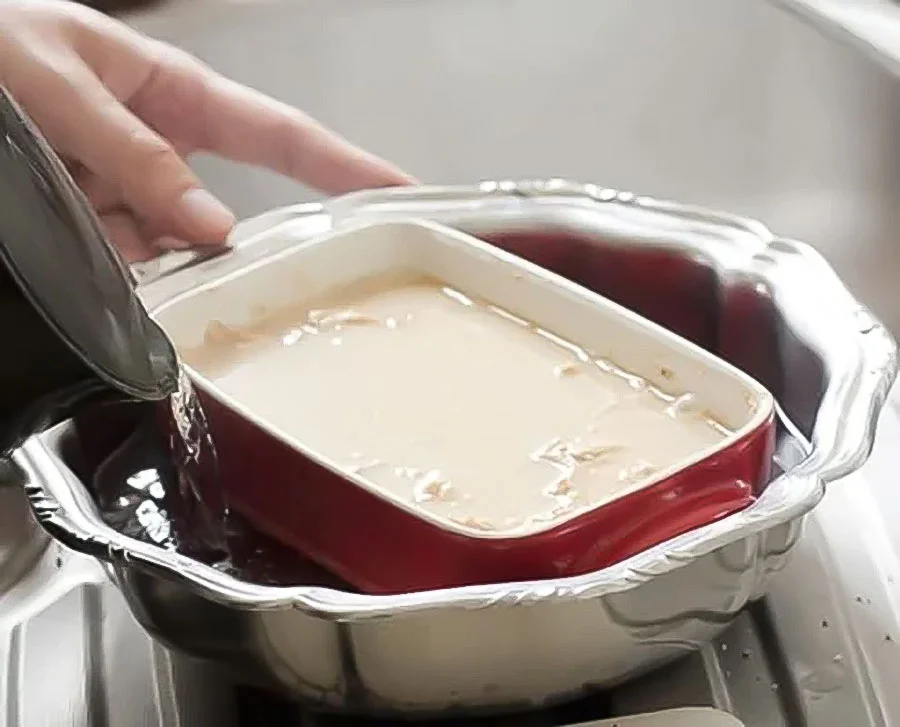Foie gras terrine is a smooth, buttery pâté, made from duck or goose liver, beloved for its rich flavor and velvety texture. While there is quite a bit of controversy surrounding its production—requiring specially fattened animals—it remains one of the most classic symbols of French cuisine globally.
To prepare foie gras, you will want to start with liver that has minimal veins—fresh liver requires gentle vein removal, while frozen liver is often pre-cleaned. If frozen, defrost it slowly in the fridge for about 24 hours before cooking.
The key to perfect foie gras is gentle cooking, as goose fat melts quickly. In France, it’s baked in a ceramic dish using the bain-marie technique—a water bath that ensures even, delicate cooking. Once cooked, it’s pressed under a weight for a smooth, dense texture and refrigerated for three days to let the flavors develop.
Foie gras is traditionally seasoned with fleur de sel, pepper, and sweet white wine like Sauternes, though brandy or cognac can be used as substitutes. Serve it chilled on baguette slices or pain d’épices, a spiced bread with hints of ginger and cinnamon. Pair with sweet accompaniments like onion marmalade, figs, or plum compote, and a glass of sweet wine to match the preparation.
How to Make Foie Gras Terrine
1. Prepare the Foie Gras:
- If using frozen foie gras, defrost it in the refrigerator for 24 hours before starting.
- Carefully separate the foie gras into two lobes. You will see a natural line where they divide—just follow it with your hands or a knife.
2. Clean the Liver:
- Inspect both lobes and cut out any red spots or blood traces with a small knife.
- Gently remove any visible veins by pulling them out with the tip of your knife or tweezers. Be patient and careful not to tear the lobes.
- Here is a very good video guide to separating, cleaning and preparing the foie gras for the oven.
3. Season the Foie Gras:
- Season both lobes generously with freshly ground black pepper and fleur de sel.
- Place the lobes into a ceramic baking dish. Gently press the foie gras into the dish with your hands or a spoon to ensure it fits snugly and evenly, and pour the 1/3 cup of wine evenly over the foie gras.
4. Prepare the Water Bath:
- Preheat your oven to 212°F (100°C).
- Place the ceramic baking dish inside a larger baking pan. Add hot water to the larger pan so that it reaches halfway up the sides of the smaller dish (this creates a gentle water bath, or “bain-marie”).
5. Bake the Foie Gras:
- Bake for 40 minutes at 212°F (100°C). The foie gras will soften and render some fat during cooking.
6. Collect the Rendered Fat:
- Remove the ceramic dish from the oven. Using a spoon, carefully collect the melted fat that has surfaced on top of the foie gras. Place the fat into a separate bowl and set aside.
7. Weight and Chill the Foie Gras:
- Cover the top of the foie gras with parchment paper or plastic wrap.
- Place a weight (like a small, flat pan or heavy plate) on top to gently compress the foie gras. This step helps to firm up the texture and shape.
- Leave the weight in place for 30 minutes, then remove it. Keep the foie gras covered and refrigerate for 24 hours.
8. Final Chill and Fat Coating:
- Melt the reserved fat you saved earlier. Remove the foie gras from the fridge and uncover it.
- Pour the melted fat evenly over the top to create a protective layer.
- Return the foie gras to the refrigerator for an additional 48 hours. This step allows the flavors to develop and the texture to set.
9. Serve the Foie Gras:
- When ready to serve, slice the foie gras with a sharp knife. To make clean cuts, warm the knife blade under hot water and wipe it dry between slices.
- Serve the foie gras with toasted bread, baguette slices, or brioche, and a drizzle of sweet wine or fruit compote.

Recipe Notes
- Resting Time: Allowing the foie gras to chill for 24-48 hours is essential for flavor development.
- Serving Tip: Warm your knife blade before slicing to achieve clean, smooth cuts.
- Storage: Store leftovers in an airtight container in the refrigerator for up to 5 days.

How to Make Foie Gras Terrine
- Total Time: 70 mins plus chilling time
- Yield: 6-8 servings 1x
Description
Learn how to make the legendary French delicacy at home, makes for a very elegant appetizer with rich flavor and a smooth texture.
Ingredients
Instructions
1. Prepare the Foie Gras:
- If using frozen foie gras, defrost it in the refrigerator for 24 hours before starting.
- Carefully separate the foie gras into two lobes. You will see a natural line where they divide—just follow it with your hands or a knife.
2. Clean the Liver:
- Inspect both lobes and cut out any red spots or blood traces with a small knife.
- Gently remove any visible veins by pulling them out with the tip of your knife or tweezers. Be patient and careful not to tear the lobes.
- Here is a very good video guide to separating, cleaning and preparing the foie gras for the oven.
3. Season the Foie Gras:
- Season both lobes generously with freshly ground black pepper and fleur de sel.
- Place the lobes into a ceramic baking dish. Gently press the foie gras into the dish with your hands or a spoon to ensure it fits snugly and evenly, and pour the 1/3 cup of wine evenly over the foie gras.
4. Prepare the Water Bath:
- Preheat your oven to 212°F (100°C).
- Place the ceramic baking dish inside a larger baking pan. Add hot water to the larger pan so that it reaches halfway up the sides of the smaller dish (this creates a gentle water bath, or “bain-marie”).
5. Bake the Foie Gras:
- Bake for 40 minutes at 212°F (100°C). The foie gras will soften and render some fat during cooking.
6. Collect the Rendered Fat:
- Remove the ceramic dish from the oven. Using a spoon, carefully collect the melted fat that has surfaced on top of the foie gras. Place the fat into a separate bowl and set aside.
7. Weight and Chill the Foie Gras:
- Cover the top of the foie gras with parchment paper or plastic wrap.
- Place a weight (like a small, flat pan or heavy plate) on top to gently compress the foie gras. This step helps to firm up the texture and shape.
- Leave the weight in place for 30 minutes, then remove it. Keep the foie gras covered and refrigerate for 24 hours.
8. Final Chill and Fat Coating:
- Melt the reserved fat you saved earlier. Remove the foie gras from the fridge and uncover it.
- Pour the melted fat evenly over the top to create a protective layer.
- Return the foie gras to the refrigerator for an additional 48 hours. This step allows the flavors to develop and the texture to set.
9. Serve the Foie Gras:
- When ready to serve, slice the foie gras with a sharp knife. To make clean cuts, warm the knife blade under hot water and wipe it dry between slices.
- Serve the foie gras with toasted bread, baguette slices, or brioche, and a drizzle of sweet wine or fruit compote.
Notes
Resting Time: Allowing the foie gras to chill for 24-48 hours is essential for flavor development.
Serving Tip: Warm your knife blade before slicing to achieve clean, smooth cuts.
Storage: Store leftovers in an airtight container in the refrigerator for up to 5 days.
- Prep Time: 30 mins
- Chilling Time: 72 hours
- Cook Time: 40 mins
- Category: Appetizer
- Method: Baking
- Cuisine: French
Nutrition
- Serving Size: 1 slice
- Calories: 280
- Sugar: 1g
- Sodium: 340mg
- Fat: 24g
- Saturated Fat: 14g
- Unsaturated Fat: 7g
- Trans Fat: 0g
- Carbohydrates: 2g
- Fiber: 0g
- Protein: 6g
- Cholesterol: 110mg


















I think Foie Gras is just the whole liver of the duck or goose, not a Paté, not buttery, it crumbles when cut with a fork. Basically the whole liver organ served on a plate. Your recipe is for Duck or goose liver pate, which is not Foie gras.
You are absolutely right, this is Foie Gras Terrine.
I love fois gras!
Foie gras is one of the major delicacies of the world and this recipe is really traditional. As a French person, I approve!
If you don’t like it, don’t read the recipe, and don’t make it. I did, and it was so delicious, fantastic recipe. It did take a little time to devein, but it was oddly satisfying. Served with an apple compote and some sourdough bread, so dang good!!
How can anyone make this, it is so cruel!!
A bit of work but absolutely worth it. Best appetizer I’ve ever made.
I’m really ambivalent. I love foie gras so much, but feel bad every time I eat it. I did buy some “cruelty free” foie, and it was pretty good though. Great recipe by the way!
I made this for Thanksgiving as an appetizer, and the vein cleaning video was incredibly helpful. The foie gras was delicious, and we served it supertraditionally with grilled bread and some fig jam. Thank you, love this recipe!